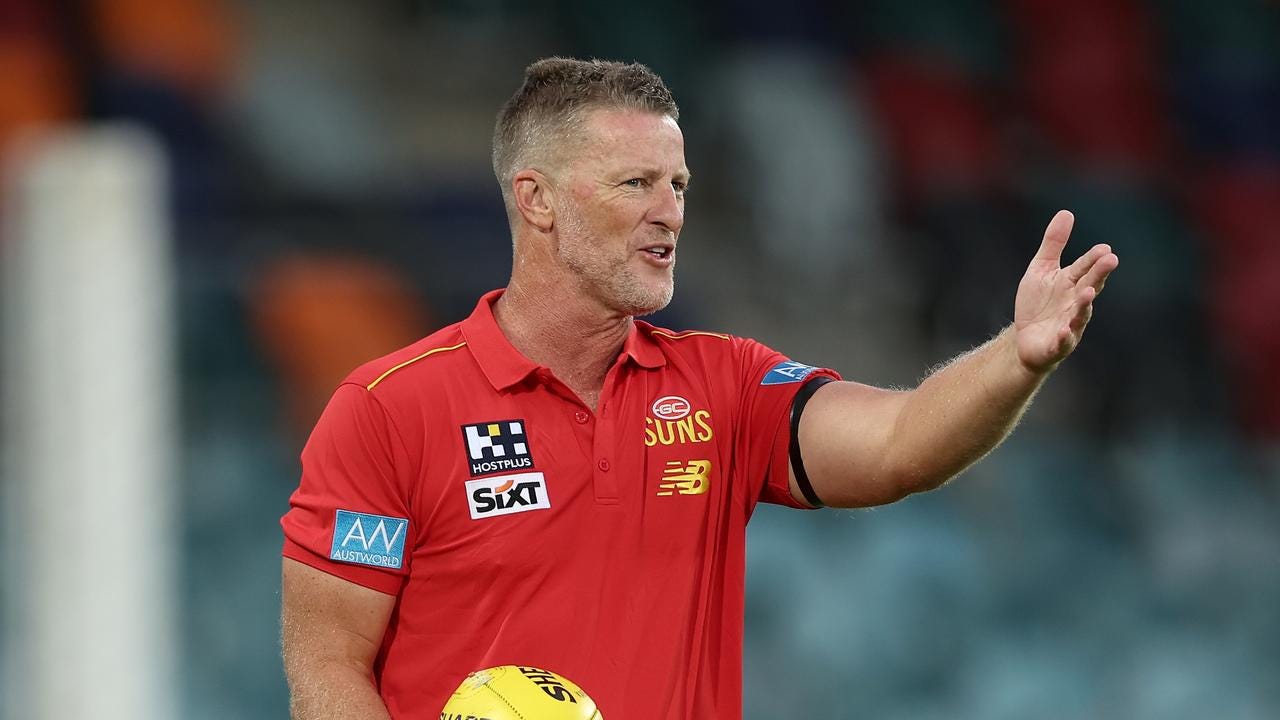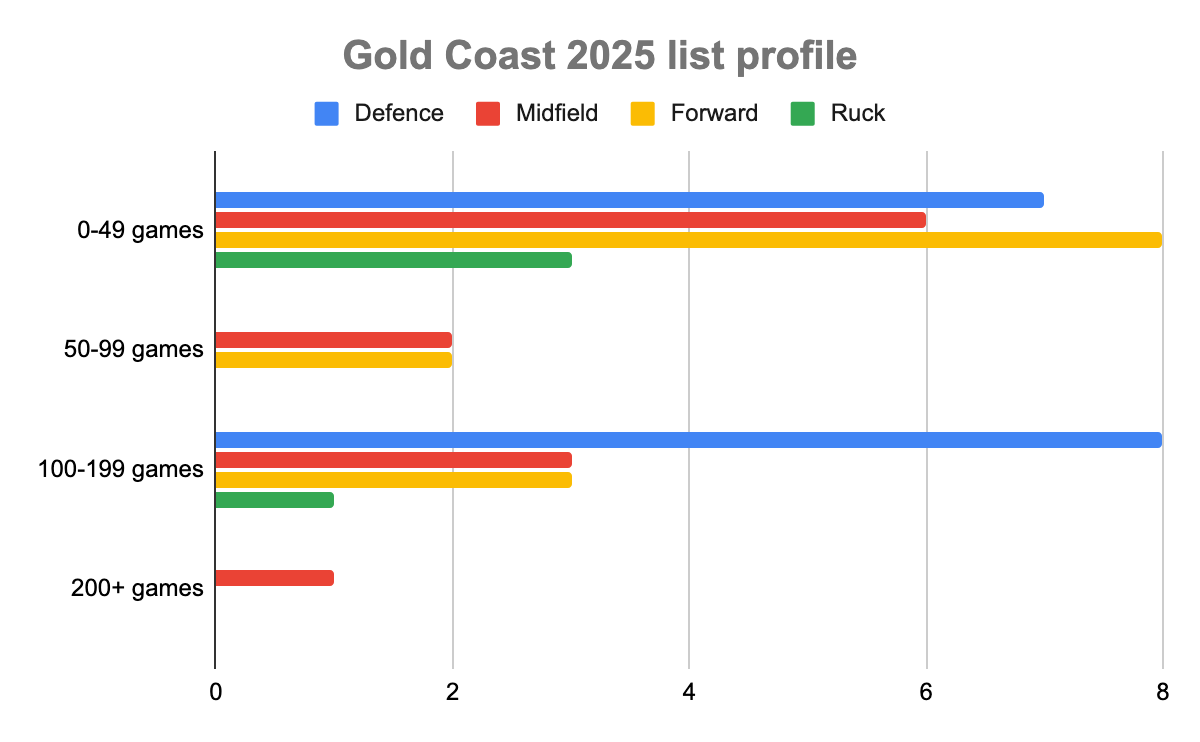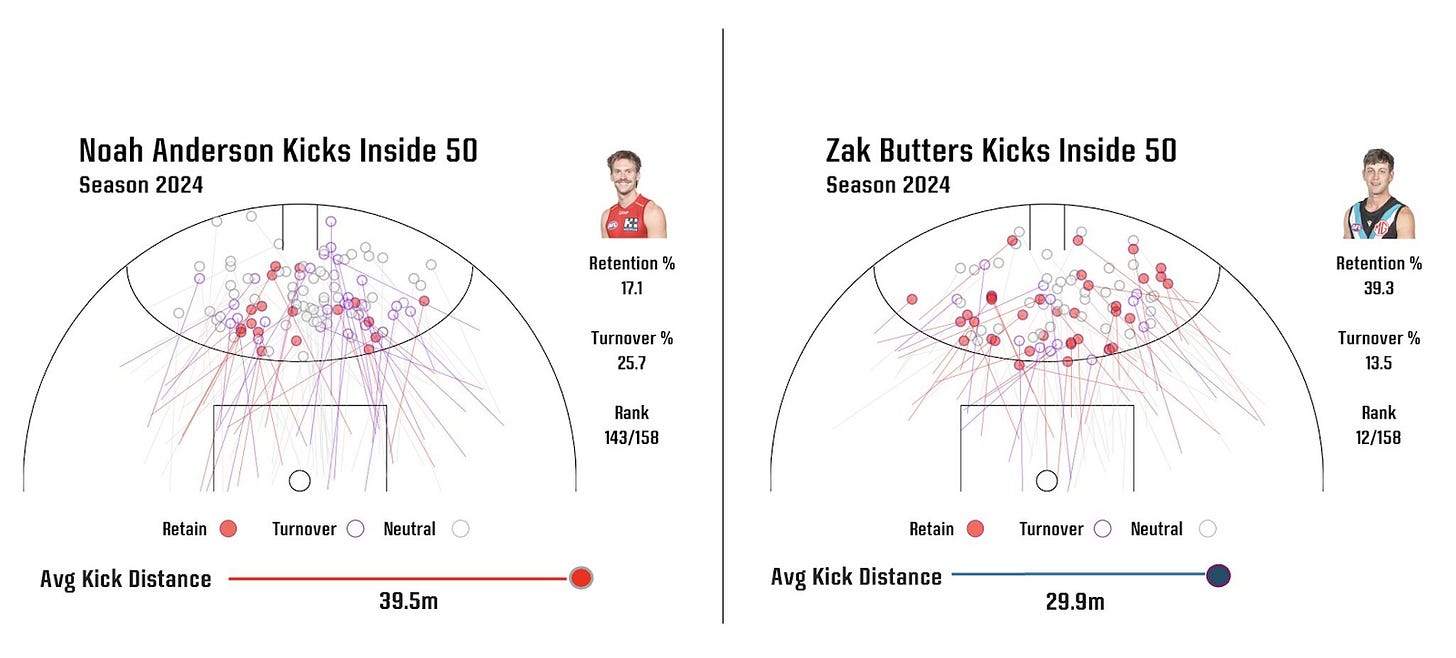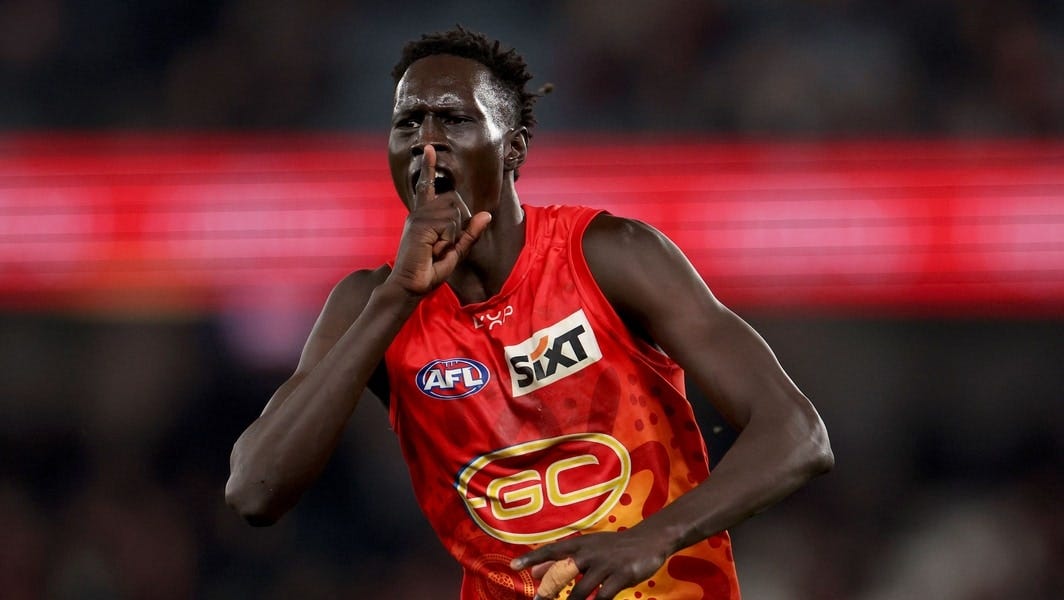2025 AFL Season Previews: Gold Coast
Sun, sand, surf, and midfield/forward connection issues.
For preview number eight, we’re going back up north.
2024 ladder position: 13th (11 wins, 12 losses)
2024 best-and-fairest: Sam Collins
Senior coach: Damien Hardwick
Story of the season
There’s no place like home. Incredibly, the Suns won every home game and lost every away game until Round 20, when the balloon was punctured by a businesslike Brisbane victory at Carrara. Most people probably thought there wouldn’t be an away win all season, until the therapeutic intervention of a generous Essendon side (and Mac Andrew, after the siren). However, that epic win came after a string of three defeats which virtually extinguished the Suns’ chances of playing finals for the first time. Beneath the surface, lots changed. But the frustrations remained much the same. All in all, Damien Hardwick’s first season on the Gold Coast brought progress – but perhaps not as much as many were expecting.
Summary of game style
Under Stuart Dew, Gold Coast prioritised winning the ball at stoppages and moving the ball up the field by foot. The Suns ranked third for clearance differential, first for contested possession share, and second for kicks as a share of disposal. A typical Suns possession chain beginning from a stoppage win was simple enough to visualise – Matt Rowell winning it in close and shovelling a quick handball to a teammate who would dump a kick forward under pressure, without much regard for where it landed. It was slow, stodgy and not particularly subtle.
Damien Hardwick quickly set about changing how the Suns won the ball and moved it. With his all-conquering Richmond side as his reference, he placed a much higher priority on forcing turnovers, particularly in the air. The Suns took more intercept marks per game than any other side in 2024, buoyed by an improved defensive zone and the aerial skills of Charlie Ballard, Mac Andrew and best-and-fairest winner Sam Collins. After winning possession, the Suns would aggressively try to punish their opponents, linking up by hand – they were 16th for kicks as a share of disposals, having been second in that metric in 2023 – and quickly entering 50.
Vast improvements in the quality of Gold Coast’s turnover game translated to significant territorial gains. The Suns went from 14th for inside-50 differential in 2024 to sixth in the first season under Hardwick. But forward connection remains an issue: in 2024, the Suns were second for kick length going inside 50 and 18th for inside-50 retention. Does anyone have a spare high half-forward?
List changes
In:
Daniel Rioli (trade – Richmond)
John Noble (trade – Collingwood)
Elliott Himmelberg (free agent – Adelaide)
Leo Lombard (2024 National Draft, pick #9 – Academy)
Cooper Bell (2024 National Draft, pick #49)
Asher Eastham (2024 Rookie Draft)
Zak Evans (Category B rookie)
Lachlan Gulbin (Category B rookie)
Max Knobel (2024 Rookie Draft)
Ben Jepson (Supplemental Selection Period)
Out:
Sandy Brock (delisted)
Sam Day (delisted)
Jack Mahony (delisted)
Hewago Oea (delisted)
Will Rowlands (delisted)
James Tsitas (delisted)
Darcy Macpherson (delisted)
Oskar Faulkhead (delisted)
Brandon Ellis (retired)
Levi Casboult (retired)
Jack Lukosius (trade – Port Adelaide)
Rory Atkins (trade – Port Adelaide)
List profile
Number of top-10 draft picks: 10 (T-1st)
Average age at Opening Round: 24.7 (9th)
Average number of games played: 71.3 (9th)
With respect to guys who are better than 99.9% of people who’ve ever kicked a footy, many of both the Suns’ incomings and outgoings will prove inconsequential in the broader scheme of things. Swapping one guy who won’t make it for a guy who probably won’t make it will not be the difference between Gold Coast winning a Premiership in the next five years and not.
However, if the success of a side’s trade period is measured by how closely it aligns with the head coach’s game plan, then Gold Coast’s must be considered a success. Jack Lukosius is an exquisitely talented player who can impact games at either end. He also – despite Hardwick’s not-quite convincing efforts to convey the opposite – was not a Hardwick player. Flipping the South Australian enabled the Suns to upgrade their 2025 draft hand while also bringing in John Noble, one of the two half-backs Hardwick clearly believes is important to executing his high-speed, turnover-oriented style. Daniel Rioli is the big fish. His run and skill should make the Suns more fluent from the back half, and his knowledge of Hardwick’s style will make him an effective on-field lieutenant. The fiery, combative (quite literally so, if one believes certain rumours) Academy product, Leo Lombard, is the pick of the Suns’ draft haul. (Post-publication edit: there are as-yet unconfirmed rumours that Lombard picked up a shoulder injury in last Thursday’s triangular scratch match against Brisbane and Collingwood that could sideline him for several months. Fingers crossed it’s not true.)
The volume of trade and draft activity has left the Suns in an interesting position regarding their list. The key defensive stocks are strong, and Rioli and Noble will add dash and rebound. Rowell, Anderson and former captain Touk Miller are a solid and complementary midfield trio, attending the vast majority of centre bounces (Sam Flanders deputised well at centre bounces when Miller missed several games with a broken wrist). But for all its qualities, especially in the clinches, it definitely lacks quality disposal. That wasn’t really a problem for Hardwick at Richmond (although Trent Cotchin and Dustin Martin were better kicks than any of the current Suns mids), but it feels as though the game demands more subtlety when entering 50 these days. I’m interested in seeing whether Flanders and Bailey Humphrey – who, until Sam Lalor was drafted, was probably the closest comparison to Dusty on an AFL list – see more midfield time in 2025.
The forward line remains a work in progress, but you can see the outline of something fairly formidable. Jed Walter looks like an outstanding prospect (more on him below) who is already winning or at least halving one-on-one contests. I’m something of a Ben King sceptic, although it’s a nice throwback to have a full-forward who kicks goals and does nothing else. Perhaps the most important question for the shape of the Suns’ forward line in 2025 will be where Hardwick chooses to play Mac Andrew. Deploying him at whatever end of the ground needs him more at the time is probably sensible. The Suns’ stock of mediums and smalls remains the obvious area of improvement and a key reason why inside-50 retention is such an issue. With the possible exception of Malcolm Rosas Jr., who almost left the club in the off-season, the Suns probably don’t have a true small forward. Nick Holman and Ben Long provide intensity and can bring the ball to ground, but not much craft. Bailey Humphrey will probably only be a half-forward until he becomes a full-time midfielder. Hardwick valued foot speed in his half-forwards at Richmond. Assuming he does the same at the Suns, you’d expect second-year mid/forward Jake Rogers (and perhaps even Leo Lombard) to feature here. But, gosh, what they wouldn’t give for a Kysaiah Pickett or a Gryan Miers.
Line rankings
Defence: Above Average
Midfield: Above Average
Forward: Average
Ruck: Above Average
The case for optimism
The Gold Coast academy is beginning to crank out the prospects at an increasing clip. In 2023, it was Walter, Rogers, Ethan Read and Will Graham. Last year, Leo Lombard. This year, Zeke Uwland and Beau Addinsall are being talked up as first-round prospects. Having a thriving academy solves so many problems at once for the Suns. It greatly simplifies their work at the draft while at the same time ameliorating the player retention problem that, frankly, totally stuffed their first decade in the AFL. It makes them feel more like a real club, organically rooted in a community, and not the outcome of a focus group. It will probably end up being beneficial from a salary cap perspective, too – players playing for their home-town club will often accept “unders”, especially if they’re competing near the top of the ladder. It’s good for the AFL if the Suns are represented by talented locals who love playing for the Suns. It’s especially good for the Suns.
That’s the broad. Now for the specific. Hardwick didn’t affect the turnaround that some people were expecting in his first season. But he indisputably made the Suns better. Gold Coast went from 14th for inside-50 differential in 2023 to sixth in 2024. From 16th to sixth for turnovers and intercept possessions. And from 15th in expected score differential to ninth. Yes, the job is still less than half done; specifically, he needs to evolve his side from one that can reliably generate turnovers into one that can reliably convert those turnovers into scores. The key to continued progress is better forward delivery, improved inside-50 pressure, and greater ability to halve contests around the ground. But despite the formidable amount of work still required, 12 months in, progress is clearly being made. A reasonably soft fixture – the AFL website’s own analysis puts it as the equal sixth-easiest (sixth seems to be a recurring theme with the Suns, hopefully for them it’s a lucky omen rather than a demonic one) – will make Hardwick confident that a maiden finals campaign is within reach.
The case for pessimism
Broadly speaking, Suns fans have plenty of reasons for optimism: they have a good list with an abundance of talented youth (and the prospect of more on the immediate horizon), a successful coach, and a more palatable brand identity than a few months ago. But that still doesn’t mean it’s all plain sailing from here. The first cause for pessimism is tactical. The second is… more existential.
I’ve already spoken a fair bit throughout this review about the Suns’ lack of connection between midfield and forward 50. Not only does that remain an issue, I’m not sure there’s a player on the Suns list that can solve it. In fact, it feels baked in. Not having a linking half-forward is a problem. But so is building around a midfield group that’s good at winning the ball but bad at using it productively. This chart, from analyst James Ives, shows the problem clearly.
Or rather, it shows the two problems clearly. I’m not using it to denigrate the new Suns captain. Zac Butters’ agility and disposal skills are uniquely good, and his strengths are slightly different to Anderson’s, who ranks as elite for clearance wins, inside-50s and metres gained. But at this stage of his career, Anderson is clearly more hammer than scalpel when it comes to gaining those metres. Iffy disposal is compounded by a forward line that hasn’t yet learnt how to lock it in. Hardwick’s dynastic Richmond side wasn't especially sophisticated, and that was OK. They were brutal and ruthless. But footy moves quickly. Opposition coaches, largely because of the success of that Tigers side, have learnt how to defend turnover much better. The Suns need to vastly improve how they enter attacking 50 and keep it there. In an era where teams are so good at scoring from their own defensive zone, constantly losing the ball when you go forward becomes more than just a hindrance – it becomes a major liability. Those improvements may well come from organic improvement (say, Jed Walter becoming a guy who clunks everything), or from tactical tweaks like nominating a different designated inside-50 kicker. But, for reasons I’m about to expand on, I’ll believe it when I see it.
Regular readers will know I prefer to keep things in the realm of the measurable. I don’t particularly like talking about individual or collective psychological traits like effort, or will, or desire. That’s not to say these things don’t exist, more that, because they’re – by definition – unmeasurable, I don’t think I or really anyone has anything interesting to say about them. This preamble, then, is a sort of apology for the question I’m about to pose: can a club have “loser energy”?
To the extent that the Suns have – or had – it, most of it has been beyond their control. The disruption caused by their introduction to the AFL immediately made fans of heartland clubs sceptical or downright hostile. The constant outflow of players probably engendered more glee than sympathy. The constant failure to make finals, derision or disinterest. This was all compounded by the fact that, while the Suns were toiling, the Giants were establishing themselves in the core narrative of the league. Until Hardwick’s arrival, the truth is that not many people outside of AFL House really cared about what happened on the Gold Coast.
Why dredge all this up? To make the point that maybe that memory seeps into the foundations of a club. Maybe veteran players channel past failures when they should instead be thinking about the prospect of future success? Perhaps, after another season of plugging away up north, Matt Rowell decides he’d actually prefer to come home after all? Clearly this is all highly unscientific. And, just as clearly, part of the reason Hardwick was brought in was to banish these negative intrusive thoughts. To eradicate the loser energy. But maybe it’s more stubborn than any of us realise.
Enjoying this preview and think a Suns-supporting friend might too? Share it with them!
Breakout player
Jed Walter was third among all key forwards in the AFL for one-on-one contest win percentage, which is, uh, fairly insane considering it was his debut season and everyone agrees that key forwards need more physical development than any other position, aside from rucks. As he gets stronger, develops his capacity to get to repeat contests, and improves his forward craft, he will get better – and the rest of the competition will have to find a way to stop him.
Most important player
Anderson or Rowell are the conventional choices, understandably so. But I suspect we’ll eventually look back on 2025 as the season where Mac Andrew emerged as the Suns’ most important player. The “swingman” is sort of like footy’s all-rounder – something many clubs seem to spend lots of time looking for, often for obscure reasons, and usually never find. But Andrew looks like the real deal. He can be deployed to equally devastating effect up forward, down back, or even in the ruck. The speed of his improvement has been rapid.
Biggest question to answer
Can Damien Hardwick take the next step in his side’s tactical evolution and turn them from being one which can generate turnovers into one that actually profits from them? His ability to answer that will determine how quickly his talented side rises up the ladder.
What success looks like
It’s got to be finals, doesn’t it? Both the club and the AFL have invested a hell of a lot in making this whole thing work. Last season represented solid progress, even if it didn’t bring the finals appearance a lot of pundits thought it would. There are fewer excuses this time around.
In a nutshell
For the Suns to rise, Damien Hardwick must figure out how to improve their ball use and – above all – their connection going inside 50. He has the talent. He doesn’t quite have the system. At least not yet.
Agree? Think I’m a fool who’s biased against the Suns? Share your thoughts in the comments.







